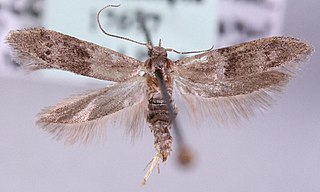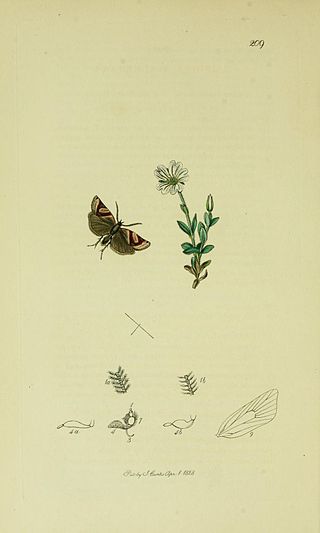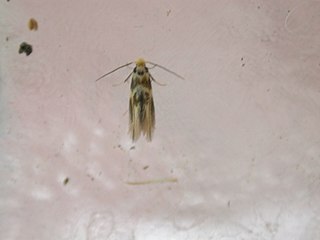
Carl Peter Thunberg, also known as Karl Peter von Thunberg, Carl Pehr Thunberg, or Carl Per Thunberg, was a Swedish naturalist and an "apostle" of Carl Linnaeus. After studying under Linnaeus at Uppsala University, he spent seven years travelling in southern Italy and Asia, collecting and describing people and animals new to European science, and observing local cultures. He has been called "the father of South African botany", "pioneer of Occidental Medicine in Japan", and the "Japanese Linnaeus".

Boloria is a brush-footed butterfly (Nymphalidae) genus. Clossiana is usually included with it nowadays, though some authors still consider it distinct and it seems to warrant recognition as a subgenus at least.

Chrysoesthia is a genus of moths in the family Gelechiidae.

Hypatopa is a genus of moths in the family Blastobasidae.

Donacaula forficella is a species of moth of the family Crambidae described by Carl Peter Thunberg in 1794. It is found in China (Heilongjiang), Europe and South Africa.

Tinea trinotella is a species of tineoid moth. It belongs to the fungus moth family (Tineidae), and therein to the nominate subfamily Tineinae. It was once used as type species of a distinct genus Acedes, but this is synonymized today with Tinea, the type genus of Tineinae, Tineidae and the superfamily Tineoidea.

Philedonides lunana, also known as the heath tortrix and Walker’s Lanark tortrix, is a moth of the family Tortricidae. It was first described by Carl Peter Thunberg in 1784 and is found in most of Europe.

Bucculatrix thoracella, the lime bent-wing, is species of moth in the family Bucculatricidae, and was first described in 1794 by Carl Peter Thunberg as Tinea thoracella. It is found throughout Europe with exception of Ireland and the Balkan Peninsula, and in Japan, where it occurs on the islands of Hokkaido and Honshu.
Perittia farinella is a moth of the family Elachistidae. It is found in most of Europe.
Bandera binotella is a species of snout moth in the genus Bandera. It was described by Philipp Christoph Zeller in 1872. It is found in North America, including Texas, New Mexico, California, Colorado and Alberta.

Crambus hamella is a species of moth in the family Crambidae described by Carl Peter Thunberg in 1788. It is found in most of Europe, east to the Russian Far East and Japan. It is also found in North America, including Alberta, Arizona, Manitoba, Michigan, Oklahoma and Ontario.

Hypatopa inunctella is a moth in the family Blastobasidae. It is found in most of Europe.

Haplotinea insectella, the drab clothes moth or fungus grain moth, is a moth of the family Tineidae. It was described by Johan Christian Fabricius in 1794. It is found in all of Europe, except Ireland, the Iberian Peninsula and the western and southern part of the Balkan Peninsula. It is also found in North America. The species is often found in warehouses, granaries, mills and farm buildings.

Greta Tintin Eleonora Ernman Thunberg is a Swedish environmental activist known for challenging world leaders to take immediate action for climate change mitigation.

"The 1975" is a 2019 song by the English band of the same name from their fourth studio album, Notes on a Conditional Form. It was released on 24 July 2019, and included on the album as the opening track in May 2020. It continues the tradition of the band's albums opening with an eponymous song, but whereas the previous three had a shared set of lyrics sung by Matty Healy, the 2019 song uses different lyrics delivered by the environmental activist Greta Thunberg. She calls for civil disobedience in response to climate change, to reduce greenhouse gas emissions, in a modified version of her speech "Our House Is on Fire" from the 2019 World Economic Forum.













